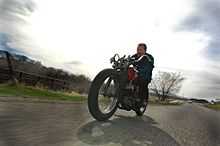Jeff Decker
| Jeff Decker | |
|---|---|
 Jeff Decker | |
| Born |
June 14, 1966 Torrance, California |
| Nationality | American |
| Alma mater | Brigham Young University |
| Occupation | Sculptor |
| Known for | Bronze sculptures, The Hill Climber |
| Religion | Mormon |
| Spouse(s) | Kelly Lei Decker |
| Website | |
| JeffDeckerStudio.com | |
Jeff Decker is a sculptor and historian who is known for his bronze sculptures, the most notable of which is titled "By the Horns" (also known as The Hill Climber), a 16-foot-tall, 5,000-pound bronze located on the grounds of the Harley Davidson Museum.[1] His bronze-cast sculptures depicting the synergy of man and modern machines, particularly historic motorcycles, is known in both the motorcycling community and the world of fine art.[2] As of 2009, Decker was Harley-Davidson's official sculptor.[3]
Professional background
Decker is the son of Allen and Lana Decker. Steeped in the southern California car culture of the 1960s, Decker learned the ways of his father.[4] An intense collector, Decker's father owned one of the area's largest flathead speed equipment collections.
Working full-time at a bronze casting foundry, Decker's first idea was to capture Man's quest for speed in all vehicles. His first sculpture was a 1924 Miller Indy car. Next came the Baby Bootlegger, a 1922 world record-holding speedboat.[5]
On display at Bob Dron Harley-Davidson located in Oakland, California, Decker created a life-size bronze statue from a famous photograph of Joe Petrali showing him astride a Harley Streamliner, taken during Petrali's historic 136 mile per hour record setting run at Daytona on March 13, 1937.[6] and is the only bronze sculpture artist licensed by Harley Davidson to replicate their products. Decker also created a five-foot-tall, about 1,000 pound bronze of Elvis with a Harley-Davidson motorcycle he owned, a 1956 KHK model.[3]
Bronze Sculptures
| Name | Year | Size | Weight |
|---|---|---|---|
| The 1924 Miller 91 Indy Car | 1994 | 26″ × 12″ × 12″ | 60 pounds |
| The Baby Bootlegger | 1995 | 42″ × 12″ × 8″ | 60 pounds |
| The Flying Merkel | 1997 | 22″ × 13″ × 8″ | 55 pounds |
| Jim Davis Trophy Bust | 1998 | 18″ × 6″ × 6″ | 20 pounds |
| The 1915 Cyclone | 1998 | 22″ × 13″ × 8″ | 55 pounds |
| Flat Out at Bonneville | 1999 | 42″ × 12″ × 32″ | 300 pounds |
| Tilt & Turns | 1999 | 24" x 24" x 12" | 75 pounds |
| The 1916 Big Valve Excelsior | 2000 | 22″ × 13″ × 8″ | 55 pounds |
| The 1912 Indian Big Base 8 valve racer | 2000 | 22″ × 13″ × 8″ | 55 pounds |
| The 1916 8 Valve Harley-Davidson works racer | 2000 | 22″ × 13″ × 8″ | 55 pounds |
| Neck and neck with Death | 2000 | 7’ x 2’ x 2’ | 300 pounds |
| The Bullet 1/2 scale | 2001 | 44″ × 28″ × 28″ | 300 pounds |
| The Bullet 1/4 scale | 2002 | 22″ × 14″ × 14″ | 50 pounds |
| Slant Artist | 2003 | 18″ × 14″ × 28″ | 20 pounds |
| Petrali | 2003 | 7′ × 2′ × 4′ | 800 pounds |
| Petrali/Marquette-size | 2004 | 18″ × 8″ × 10″ | 25 pounds |
| Harley-Davidson’s 1000+4 | 2004 | 18″ × 8″ × 12″ | 20 pounds |
| Ruby | 2005 | 18″ × 8″ × 12″ | 25 pounds |
| Daytona | 2006 | 28″ × 22″ × 13″ | 60 pounds |
| West Was Won | 2007 | 36″ × 20″ × 18″ | 110 pounds |
| The King and his Ride | 2007 | 18″ × 8″ × 12″ | 30 pounds |
| By the Horns (The Hill Climber) | 2008 | 9′ × 5′ × 18′ | 5 tons |
References
- ↑ Schmid, John. "Capturing the Harley Spirit". Capturing the Harley Spirit. Journal Sentinel. Retrieved 3 March 2011.
- ↑ Morgan, Felicia. "Rider's Spotlight: Jeff Decker". Canonball Endurance Run. Retrieved 3 March 2011.
- ↑ 3.0 3.1 Migliore, Greg (February 26, 2009). "Elvis immortalized on bronze Harley". Autoweek.
- ↑ "Interview: Jeff Decker". Bike Exif. Retrieved 3 March 2011.
- ↑ "Jeff Decker: Artist, Historian, Motorhead". Ed Youngblood's Motohistory. Retrieved 3 March 2011.
- ↑ Davis, Miles (January 2007). "Joe Petrali: Hometown Hero". Walneck's Classic Cycle Trader (Woodridge, IL: Dominion Enterprises): 127. ISSN 1051-8088. OCLC 22125719.